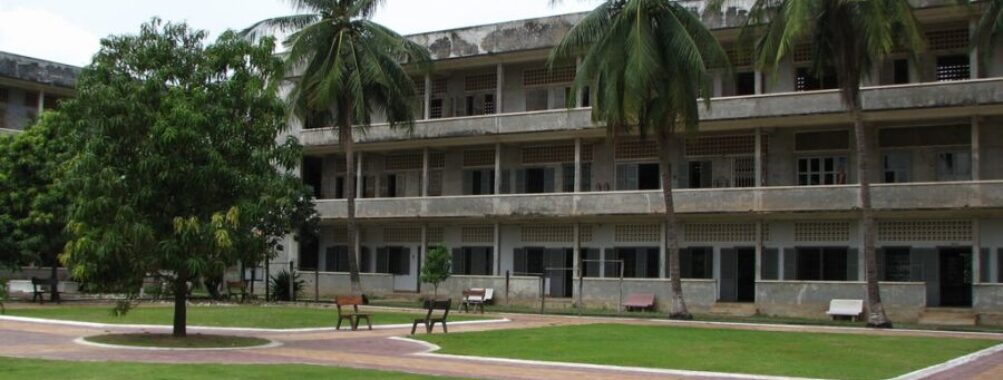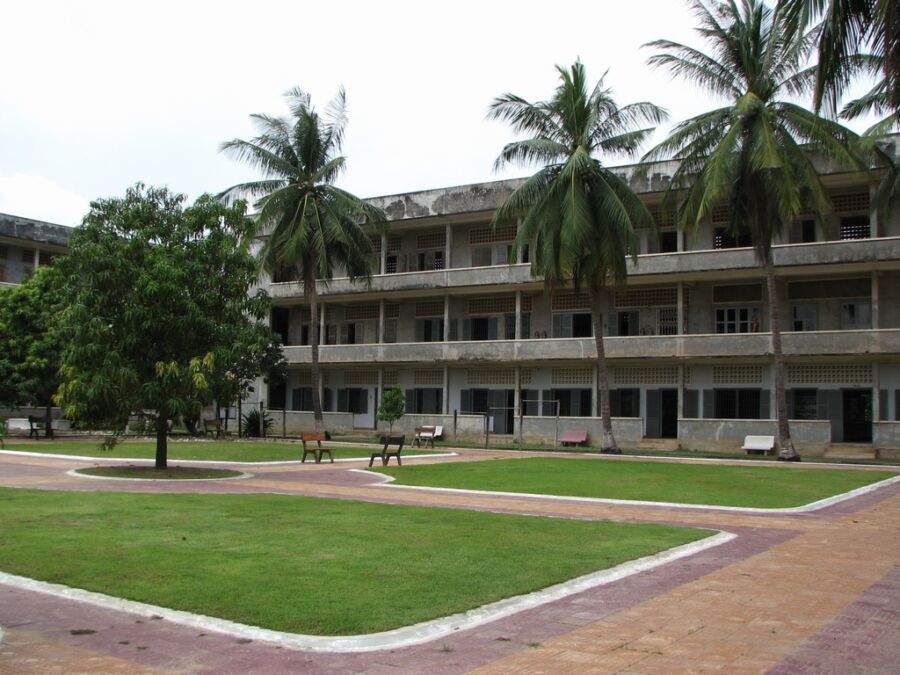
Tuol Sleng Genocide Museum
History and Significance

The Tuol Sleng Genocide Museum, formerly Tuol Svay Prey High School, holds a gruesome significance in Cambodian history. Once converted into Security Prison 21 (S-21) by the Khmer Rouge regime, it became one of the most notorious sites of interrogation and detention. Between 1975 and 1979, this prison saw the detention, torture, and eventual execution of thousands of Cambodians. The school-turned-prison symbolizes the tragic era of Pol Pot’s Democratic Kampuchea, marking its role as a critical site in the Cambodian genocide. The museum is a memorial site that has preserved the haunting history to ensure such atrocities are never forgotten.
In January 1979, the Vietnamese forces liberated Phnom Penh, uncovering the horrors within the walls of Tuol Sleng. The site was then turned into a museum to document the harsh reality of the Khmer Rouge regime. Today, it stands as a testimony to the resilience of the human spirit, offering educational insights into the brutal past of Cambodia. The Documentation Center of Cambodia has played a significant role in gathering and preserving the history. This museum serves as an international symbol of the grim realities of genocide and the need for global awareness and prevention.
Main Attractions and Activities
When visiting the Tuol Sleng Genocide Museum, several main attractions stand out, providing a deep understanding of the terrors inflicted during the Khmer Rouge era. The rooms are filled with haunting photographs of prisoners taken during their incarceration. Each of these faces tells a heart-wrenching story of suffering and resilience. Visitors can also explore the original equipment used for torture and interrogation, bringing a harrowing sense of realism to the museum experience. This vivid portrayal of the past makes the museum a gripping yet necessary destination.
The museum also offers guided tours that delve deep into the site’s intricate history. Knowledgeable guides share detailed narratives about the prison’s daily operations, the inhumane conditions faced by the detainees, and the courageous stories of survivors like Bou Meng. Another poignant site is the courtyard, where the gallows and makeshift cells still stand, evoking powerful emotions in every visitor. The activities here are designed to leave a lasting impression, encouraging visitors to be messengers who share the lessons learned with the world.
Visitor Experience
Visiting the Tuol Sleng Genocide Museum is an emotional journey that profoundly impacts all who walk through its doors. The museum’s exhibitions are meticulously curated to immerse visitors in the raw, unsettling truths of the Cambodian genocide. Audio guides are available in multiple languages, providing comprehensive information and personal stories that add depth to the experience. Walking through the former prison cells, with walls covered in heart-wrenching photographs and testimonies, visitors can’t help but feel the weight of history bearing down on them.
The museum’s atmosphere is both sobering and enlightening. Visitors often find themselves grappling with a mix of sadness and reverence as they learn about the unimaginable suffering endured by the prisoners. The interactive exhibits and multimedia presentations make it an engaging yet heartrending experience. Despite the heavy subject matter, the museum also offers moments of reflection and hope, showcasing the resilience of the human spirit. This deep and meaningful experience ensures that the lessons of the past are etched into the memory of every visitor, fostering a commitment to never forget the atrocities of the Cambodian genocide.
Tips for Visitors
Preparing for a visit to the Tuol Sleng Genocide Museum involves more than just purchasing a ticket. Given the heavy nature of the exhibits, it is advisable to approach the visit with a respectful and reflective mindset. Comfortable footwear is recommended, as you will spend several hours walking through the expansive grounds and multiple levels of the former high school. Bringing water is also crucial, as the climate in Phnom Penh can be quite warm and humid. While taking photos is usually permitted, visitors should do so with sensitivity to the gravity of the site.
Opting for a guided tour can be immensely valuable for those looking to gain deeper insight. The guides are often well-versed in the historical context and can provide a more nuanced understanding of the events at S-21. Arriving early in the day can help avoid the crowds, offering a more contemplative experience. Since the museum is close to Choeung Ek, also known as the Killing Fields, many visitors choose to visit both sites in one day for a more comprehensive understanding of the atrocities committed during the Khmer Rouge regime.
Accessibility and Facilities
The Tuol Sleng Genocide Museum has made efforts to be accessible to a wide range of visitors, though the nature of the site presents certain challenges. The main buildings have ramps and basic facilities to accommodate those with mobility issues, although not every area is entirely wheelchair-friendly due to the historical architecture. Restrooms and resting areas are available, providing essential conveniences for guests. The museum shop offers a selection of books, documentaries, and souvenirs that help preserve the memory of the Cambodian genocide. This ensures that visitors have both a meaningful and comfortable visit.
Additionally, informative plaques and audio guides in multiple languages make the museum experience accessible to international visitors. The museum is committed to inclusivity, ensuring that as many people as possible can learn about this critical period in Cambodian history. These efforts underscore the importance of making the lessons of the past available to all, reinforcing the museum’s role as an educational and memorial site. Despite some limitations, the facilities at Tuol Sleng are designed to enhance the visitor experience, providing a respectful and engaging environment to reflect on the horrors of the past.
Unique Features
What sets the Tuol Sleng Genocide Museum apart from other memorials is its unflinching and raw portrayal of the Cambodian genocide. The site itself, a former detention center of the Khmer Rouge, offers an unparalleled authenticity. One of the most striking features is the haunting gallery of photographs taken of prisoners upon their arrival at S-21. These images, alongside the preserved cells and interrogation rooms, create a visceral connection to the past. The meticulous preservation of these artifacts provides a stark and poignant reminder of the human cost of genocide.
Another unique aspect is the museum’s inclusion of personal testimonies and stories from survivors like Bou Meng, who bring an invaluable perspective to the exhibitions. These firsthand accounts offer a powerful narrative that complements the historical data, helping visitors to grasp the full extent of the atrocities committed. Furthermore, the museum collaborates with the Documentation Center of Cambodia to keep the historical records updated, ensuring that new findings and stories are continually integrated into the exhibition. This commitment to preserving history makes the Tuol Sleng Genocide Museum a unique and essential site for learning and remembrance.
Overall Impressions
The Tuol Sleng Genocide Museum leaves visitors with a profound sense of reflection and empathy. It stands as a critical reminder of the atrocities committed under the Khmer Rouge regime, serving as both a historical record and a beacon of remembrance. Through its meticulously preserved exhibits and emotionally charged atmosphere, the museum fosters a deep understanding of the Cambodian genocide. The suffering, resilience, and survival stories resonate long after leaving the grounds, making a lasting impression on all who visit. This museum is not just a place to learn about history; it is a site that deeply moves the soul, urging visitors to advocate for peace and humanity.
As a memorial site of the S-21 detention center, the museum’s raw portrayal of the horrors faced by thousands offers an educational and emotional journey. Many visitors contemplate the stark realities of what occurred, leaving with a renewed sense of purpose to ensure that such tragedies are never repeated. The Tuol Sleng Genocide Museum is a powerful testament to the importance of remembering and learning from the past. Its overall impact is both humbling and enlightening, making it an essential stop for anyone looking to understand the full scope of Cambodia’s history.
Pros and Cons
Visiting the Tuol Sleng Genocide Museum has pros and cons, though the overall experience is profoundly impactful. One of the major pros is the museum’s commitment to historical accuracy and preservation. The meticulous documentation and preserved artifacts offer an unvarnished look at the realities of the S-21 prison, providing an invaluable educational experience. The availability of knowledgeable guides and comprehensive audio tours enhances the learning aspect, making the history accessible to visitors from around the world. The museum’s proximity to other significant sites like Choeung Ek and the Killing Fields also adds value to the visit.
Conversely, the content and atmosphere can be exceptionally heavy, making it emotionally challenging for some visitors. The raw depictions of torture and suffering are not suitable for everyone, particularly children or those who may find such topics distressing. Additionally, the historical architecture of the site means that not all areas are fully accessible to individuals with mobility issues. Despite these drawbacks, the importance of the museum’s mission to educate and preserve the memory of the Cambodian genocide often outweighs the cons. It remains an essential stop for anyone seeking to understand this dark chapter in Cambodia’s history.
Location
Places to Stay Near Tuol Sleng Genocide Museum
Find Tours in Kampong Speu
Explore More Travel Guides
No reviews found! Be the first to review!